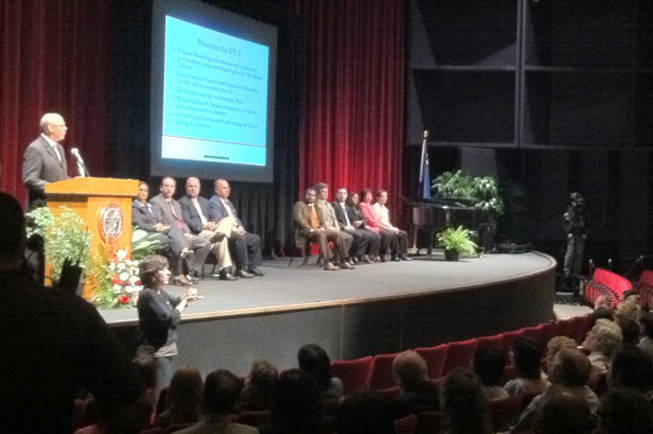
UNLV public affairs
UNLV President Neal Smatresk delivers his State of the University address Tuesday morning on campus.
Tuesday, Sept. 14, 2010 | 1:17 p.m.
Related Document
Sun Coverage
Sun Archives
- University system: Enough is enough with the budget cuts (9-3-2010)
- Board of Regents backs call for bigger higher education budget (8-28-2010)
- Board of Regents asks for increase in state funding (8-27-2010)
- Higher education wants bigger slice of state budget pie (8-24-2010)
- State education officials fear deep cuts for public schools (6-14-2010)
- $2.5 billion state budget deficit: ‘Best-case scenario’ (4-23-2010)
- Regents umbrella will help shield higher education from budget cuts (3-20-2010)
- Even UNLV’s nursing school steels for budget cuts (3-3-2010)
- Gibbons: School districts should brace for 10 percent cuts (2-2-2010)
- College students band together, rally against budget cuts (1-22-2009)
- Chancellor calls Nevada schools a ‘disaster’ (1-23-2009)
- UNLV fundraising campaign falls short, so deadline extended (12-18-2008)
- Emotional farewells at Regent’s meeting (12-5-2008)
- Rogers to budget cut protestors: Glad you’re here (12-4-2008)
In a sweeping defense of higher education, UNLV President Neal Smatresk said today that UNLV will consider new ways to raise revenue, including differential tuition for students.
He said UNLV may consider limiting enrollment and tightening admissions standards but had no immediate plans to do so.
He also said politicians and political candidates were engaging in "magical thinking" in an age of austerity about how to fund UNLV and higher education while preserving the university system.
Smatresk said in what is known as the State of the University address, that in view of the looming budget crisis UNLV will consider charging what is known as "differential tuition."
Under that scenario, students in some majors, such as sciences, would be charged higher tuition and fees than students in other majors, such as liberal arts, which are less costly to offer in terms of laboratories, equipment and other operations. He did not go into detail.
UNLV will also lobby the state Legislature to keep more of the money raised from student tuition and fees on campus. Currently, portions of the fees go to pay for non-education programs in the state.
Smatresk told reporters later that the university may have to consider limits on enrollment and raising the grade point average for admission, which is currently 3.0, or a "B" average in high school.
"Right now we have no immediate plans to change that," he said. "However, as we look at limiting enrollment we're certainly going to have to consider what the entrance requirements for students are and also consider our ability to serve them in a good educational environment."
He added: "We don't want an overcrowded environment."
Enrollment figures this year for UNLV, which are not yet final, appear to be about 28,000, or down 1 percent from the year earlier.
"Classes this year are full," he said. "They're bursting at the seams. In fact, if we had many more students it would be really difficult to accommodate them."
Past budget cuts are making it difficult to preserve the core of UNLV, its faculty, which has taken decades to recruit, he said.
"The toughest part right now," he said, "is we haven't been able to offer, for example, to our faculty cost-of- living and merit raises, and benefits are being eroded. That makes our faculty ripe for poaching by other high-quality institutions. We've lost faculty to Berkeley, University of Georgia, University of Texas, University of Michigan."
Asked, in summary, what was the state of UNLV, Smatresk replied: "We're OK, but we're on thin ice."
In his speech, Smatresk said UNLV was preparing a report that would detail UNLV's economic contribution to the state economy. He said it exceeded $1 billion.
A shortfall of $3 billion is projected by the state budget director's office in a two-year budget of $6.5 billion.
Gov. Jim Gibbons has asked for 10 percent budget cuts in all state agencies. But the university system, which regards itself as independent because its board is elected, not appointed, rejected the cuts and is seeking more money.
The Legislature meets in February to find ways to balance the budget.
"The talk lately," Smatresk said in his speech, "has been all about how we're going to cut higher education, how we're not going to raise tuition, but we're going to graduate more students, and we're going to make them much more successful."
Smatresk paused and said, "if we could cut ourselves to greatness, I would have done it a long time ago. So let's consider less magical thinking and more positive ways for how we should try to engage the future."

Join the Discussion:
Check this out for a full explanation of our conversion to the LiveFyre commenting system and instructions on how to sign up for an account.
Full comments policy